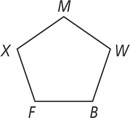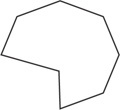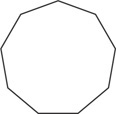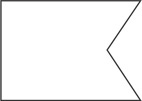You can also classify a polygon as concave or convex, using the diagonals of the polygon. A diagonal is a segment that connects two nonconsecutive vertices.

A convex polygon has no diagonal with points outside the polygon.

A concave polygon has at least one diagonal with points outside the polygon.
In this textbook, a polygon is convex unless otherwise stated.
Example 2
Classify the polygon by its number of sides. Tell whether the polygon is convex or concave.
The polygon has six sides. Therefore, it is a hexagon.
No diagonal of the hexagon contains points outside the hexagon. The hexagon is convex.

Exercises
Is the figure a polygon? If not, explain why.
Name the polygon. Then identify its sides and angles.
Classify the polygon by its number of sides. Tell whether the polygon is convex or concave.
Table of Contents
- 6-1 The Polygon Angle-Sum Theorems
- 6-2 Properties of Parallelograms
- 6-3 Proving That a Quadrilateral Is a Parallelogram
- 6-4 Properties of Rhombuses, Rectangles, and Squares
- 6-5 Conditions for Rhombuses, Rectangles, and Squares
- 6-6 Trapezoids and Kites
- 6-7 Polygons in the Coordinate Plane
- 6-8 and 6-9 Coordinate Geometry and Coordinate Proofs














